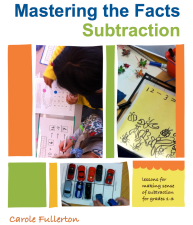Sidewalk Chalk Meets Math Game!
For those of you who are looking for ways to play together and build mathematical thinking and skills at the same time, consider this simple hopscotch game. You’ll need sidewalk chalk and a small stone. Children can play alone or in partners.
Go outside. Draw a large square on the pavement. Divide the square into at least 9 smaller squares, as shown below. This is called a matrix.
In each of the smaller squares record a number from 1 to 9. You can put them in any order. Now take a small stone and toss it onto the matrix. This is your starting square. From here, you must jump to the number that adds to give you 10.
In the game below, a child has thrown a stone onto the number 8. She stands on the number 8 then and has to jump to get to the number 2 — the missing part to get to 10.
 If there’s another child nearby, they should record the equation that matches the jump. (8 + 2 = 10)
If there’s another child nearby, they should record the equation that matches the jump. (8 + 2 = 10)
Player 2 (if there is one) takes his turn, throwing a stone and jumping from that number to the missing part to make ten. Player A records the equation.
The first player to hop on all the combinations is the winner. (And yes, landing on a 5 gets you a double jump!)
If you’re stuck inside, make the matrix on a sheet of paper and toss coins — or even Cheerios! — instead of jumping from number to number. Toss the first coin, say the number you’ve landed on, then say what the missing part is to get to the desired sum.
Of course you can change the numbers to suit the age and stage of the players…
the numbers to suit the age and stage of the players…
Consider a double-digit version (Get to 100!) or even a decimal version (Get to 5.0!). The sky’s the limit. I’ve included line masters for each of these games — and a blank grid, too — for you to use as inspiration.
Have fun… stay safe…
Carole

New Resource! Place Value For Intermediate (Grades 3 to 5)

Phew! This one has been a long time in coming… :o)
My sincere appreciation to all of you who have waited for the publication of this book. As you know, I’ve had a pretty remarkable year. I hope you’ll forgive me, knowing that only good distractions delayed its completion!
But I am pleased as punch to announce the release of Place Value For Intermediate: Building Number Sense for Grades 3-5, available now from my online store for $50.
This resource for teachers of Grades 3 through 5 features lessons designed to support deep learning of number. A wide range of both open-ended and directed tasks focus on representing, describing, comparing and ordering numbers to 100 000, as well as explorations of decimal numbers to thousandths.
Measurement experiences make up a big part of this series of tasks. The metric system and all of its place value connections is featured in explorations of linear measurement (mm, cm, m, km), perimeter (cm, mm), area (square cm and square m), mass (g, kg) and capacity (mL, L).
Addition and subtraction of large numbers and decimals are also addressed in this volume. Lessons at the grades 4 and 5 level focus on multiplication of 1 by 2- and 3-digit factors as well as 2 by 2-digit factors using the distributive property (an area model).
Assessment tasks tap into students’ understandings of these numbers and their application in the real world. Being able to see and relate to big numbers and to very small ones, to understand their relative size and to capably use these numbers to estimate is the essence of number sense.
Set up in a developmental continuum intended to facilitate the teaching of combined grades, this 352 page volume is certain to contain material to meet the needs of all learners and to inspire fun and engagement with critically important place value concepts.
When you buy the book online, you also get access to almost 40 pages of digital files and resources, which will be emailed to you as a downloadable pdf!
Thanks for your continued support and inspiration…
Enjoy!
Carole
Modelling place value with decimal numbers
Hello, my math friends!
I wanted to share something I put together not long ago to support students in understanding the value of the digits when we write decimal numbers. These decimal “tents” as I call them, are made from card stock and are folded in half to form a tent shape. Each one is cut so that the decimals on each card line up one under the other – but the digits themselves are still visible. It’s a bit hard to explain, I fear, but the following pictures should help…
This is what the cards look like, folded. I like to put a strip of magnetic tape on the back of each one so that I can stick them on the board, matching them to a model to show the same amount.
The cards are trimmed so that the decimal point falls at the same location on each of the “expanded” decimal number. On the decimal tents line master, this means you’ll slice off the light grey zeroes…
So when the cards are overlapped, the decimal number itself is clear, and made up of the parts.
It’s a powerful tool to use with students. Helping them to see that we can decompose a decimal number in the same way we do whole numbers is an important connection! This decimal tent set shows that 3 + 0.6 + 0.08 = 3.68.
Imagine a series of these tents strung along a string or wire in your classroom. Have students create a 3 digit decimal number, model it with materials and then order that number along the number line (that is, to hang their cards right on the wire!) placing it relative to the others. It’s a neat way to compare and order decimal numbers!
Enjoy!
Carole










